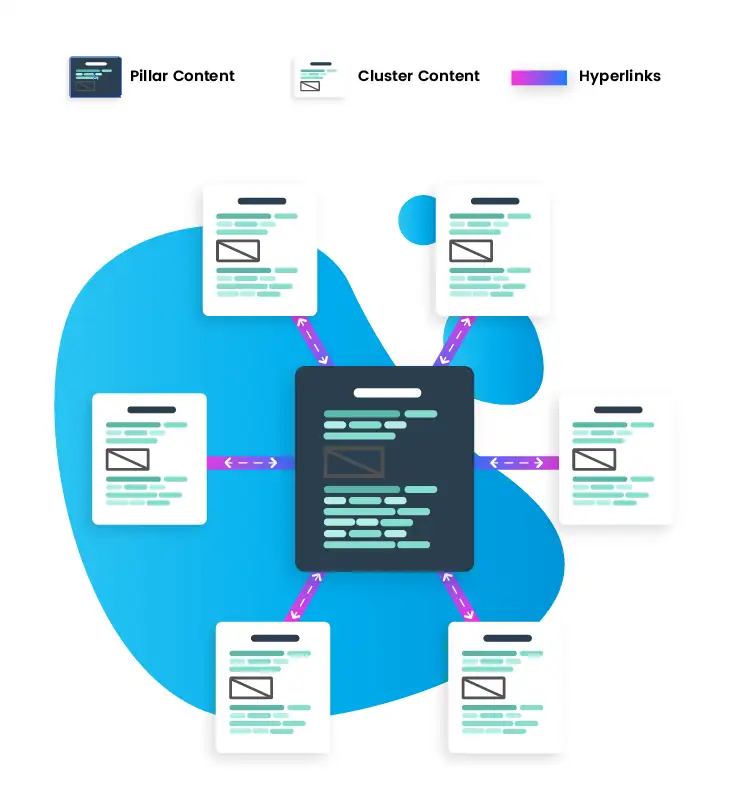Content Strategy: Pillar Pages and Cluster Content
While continuously adding fresh and relevant content to your blog is always advisable, you need to have a structure to your blog to help with your editorial calendar and to assist readers and search engines alike understand your content. You can do this by implementing a content strategy. The Content Marketing team at Reboot have experimented with a number of different strategies, and found topic clusters (composed of one key pillar post, interlinked with a range of cluster content) to be the most effective.
What is Topic Cluster Content?
 Topic clusters are a great way to organise the content on your blog and help you see the areas of content you have yet to target. Essentially, a topic cluster is comprised of a larger overarching piece of content, called a pillar page, which is broken down into smaller posts that go into more depth about a certain element of that broader topic- these smaller posts are referred to as cluster content. Let’s break down this content strategy into its different elements:
Topic clusters are a great way to organise the content on your blog and help you see the areas of content you have yet to target. Essentially, a topic cluster is comprised of a larger overarching piece of content, called a pillar page, which is broken down into smaller posts that go into more depth about a certain element of that broader topic- these smaller posts are referred to as cluster content. Let’s break down this content strategy into its different elements:
Topic cluster
This is the collection of posts around the same topic, with the pillar content at the centre, and cluster content surrounding it- linking to and from the pillar post.
Pillar post
This is an in-depth, informative post that covers a broader topic that can be broken down into more specific pieces of content. At Reboot we often structure these as ‘guides’ to a certain topic in our clients’ niche. An example of pillar content could be something like “A Complete Guide to Golf Essentials”. Within this pillar content you would write generally about the essentials needed to play golf. This guide will throw up more specific questions that you can answer with a whole new piece of content. Keyword research will also help you understand what queries people have concerning the pillar topic and can form the cluster content plan.
Cluster content
This is where you can delve deeper into specific elements of your pillar post. Cluster posts answer the questions brought about in the pillar content, but were not answered within the pillar. If we refer back to our pillar page example of “A Complete Guide to Golf Essentials”, cluster posts linking to and from this post could include “Golf club sizes for beginners”, or “How to pack a golf bag”. Neither of these were relevant enough to be answered in the pillar post, but are linked to it thematically. You can find ideas for your cluster pages by looking at the most searched for queries around your topic
What are the benefits structuring your blog in this way?
By having a topic cluster content strategy in place, you are able to see gaps in your content, where you could answer queries that potential clients may have about subjects in your niche.
Without pre-planning topic clusters, and writing posts on the fly, you are highly unlikely to cover a topic thoroughly enough, and consequently will miss out on the chance to convert searchers into customers. Equally, without keeping track or having a content strategy in place, you are likely to write about very similar topics that could have been combined into a thorough guide (pillar post) - This ends in the pages in question competing with each other for the same key terms.
 A topic cluster strategy also has technical SEO benefits too. The internet sees masses of new content added every day, and organising your blog in a pillar/cluster structure assists search engines in categorising this content thematically so that it answers search intent.This can help your rankings on the SERP as a topic cluster helps Google understand what your posts are about, and whether it answers a query effectively.
A topic cluster strategy also has technical SEO benefits too. The internet sees masses of new content added every day, and organising your blog in a pillar/cluster structure assists search engines in categorising this content thematically so that it answers search intent.This can help your rankings on the SERP as a topic cluster helps Google understand what your posts are about, and whether it answers a query effectively.
Pillar pages with cluster content also help search engines crawl your posts as it goes through one post to another, rather than trying to crawl posts as completely separate entities and trying to work out if there is a semantic connection between them.
The final SEO benefit of having this particular content strategy is that, by interlinking posts, you help spread authority across blog posts. If one post gets a lot of traffic or backlinks, this “SEO juice” is spread across the topic cluster! It also shows Google that you have authority on the subject, having explored it so thoroughly.
If you’d like more information about how we conduct our Content Marketing services at Reboot, we’d love to hear from you!
MEET THE TEAM WORKING ON YOUR ACCOUNT
